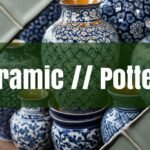Maharaja Sawai Ram Singh II of Jaipur played a pivotal role in the art form’s revival and establishment in the region.
The Making of Blue Pottery: Materials, Techniques, and Firing Process
The creation of blue pottery involves a unique set of materials and techniques that set it apart from other forms of pottery. The primary materials include quartz powder, glass powder, Fuller’s Earth (Multani Mitti), Soda Bicarbonate (Saaji), and Katira Gond (a natural gum). These ingredients are mixed with water to form a dough-like consistency, which is then left to rest for several hours. Due to the low plasticity of the dough, plaster molds are used to shape the pottery using press-molding techniques. The dough is rolled out into a flat shape and carefully placed inside the mold, with ash used to ensure it takes the mold’s form. Once the dough has dried and taken shape, the surface is smoothed, and any imperfections are filled with a slurry mixture. The piece is then coated with a slip made of quartz powder, powdered glass, and edible flour (maida), and sanded again before the underglaze is applied. The designs are hand-painted onto the pottery using a fine brush, with cobalt oxide used for the signature blue color and other metal oxides for different hues such as copper for turquoise, chromium for green, and iron for brown. The pottery is then glazed with a mixture of powdered glass, borax, zinc oxide, potassium nitrate, and boric acid. Finally, the pieces are fired in a wood-fired kiln at around 800-850 degrees Celsius. This firing process ensures that the glaze adheres well, giving the pottery its distinctive glossy finish. For more in-depth information, you might want to read about the history of Majolica techniques. Also, it’s interesting to compare these firing temperatures to those used in oxidation vs reduction firing.
Motifs, Designs, and Contemporary Adaptations
Blue pottery is characterized by its intricate and vibrant designs, which often feature floral patterns, animal figures, and geometric shapes. These motifs are hand-painted by skilled artisans, who sometimes adopt or create their own unique ideas. The color palette is dominated by the signature cobalt blue, but artisans also experiment with other colors like green, yellow, and brown. Traditional blue pottery items include vases, plates, bowls, and decorative tiles. In recent years, there has been a growing trend of adapting this art form to contemporary products and designs. Artisans are now creating modern items such as coasters, lamps, jewelry, and even furniture, incorporating the traditional blue pottery designs into these new forms. This adaptation has helped to keep the art form relevant and appealing to a wider audience, ensuring its survival in the modern market.
Blue pottery is a distinctive and celebrated art form that hails from Jaipur, Rajasthan, India, though its roots extend far beyond the subcontinent. This unique craft stands out for its striking blue hues, intricate designs, and a creation process that diverges significantly from traditional pottery. Unlike conventional pottery, blue pottery does not use clay as its primary material. Instead, it employs a special dough made from quartz stone powder, glass powder, Fuller’s Earth (Multani Mitti), Soda Bicarbonate (Saaji), and a natural gum called Katira Gond. The vibrant blue color, which gives the pottery its name, is derived from cobalt oxide. The process involves several meticulous stages, from preparing the dough to shaping, decorating, glazing, and firing the final product. Blue Pottery is not just an art form; it’s a historical narrative, a cultural emblem, and a testament to the skills of the artisans who have kept this tradition alive for centuries.
Origins and History
The journey of blue pottery to Jaipur is a fascinating tale of cultural exchange and adaptation. Its origins can be traced back to Turko-Persian roots, with influences from Persian and Central Asian designs. The art form made its way to India during the 14th century, brought by Turkish conquerors. Initially, it was used to create tiles for decorating mosques, tombs, and palaces in Central Asia. The Mughal patronage further refined the art, with artisans incorporating Mughal-inspired motifs and designs. By the 17th century, the craft had traveled from Delhi to Jaipur. Maharaja Sawai Ram Singh II of Jaipur played a pivotal role in the art form’s revival and establishment in the region. Impressed by the skills of local potters, he invited them to showcase their craft at his art school, thus ensuring the preservation and promotion of blue pottery in Jaipur. Today, Jaipur is widely recognized as the hub of blue pottery, with numerous shops and training schools dedicated to this unique art form.
Maharaja Sawai Ram Singh II of Jaipur played a pivotal role in the art form’s revival and establishment in the region.
The Making of Blue Pottery: Materials, Techniques, and Firing Process
The creation of blue pottery involves a unique set of materials and techniques that set it apart from other forms of pottery. The primary materials include quartz powder, glass powder, Fuller’s Earth (Multani Mitti), Soda Bicarbonate (Saaji), and Katira Gond (a natural gum). These ingredients are mixed with water to form a dough-like consistency, which is then left to rest for several hours. Due to the low plasticity of the dough, plaster molds are used to shape the pottery using press-molding techniques. The dough is rolled out into a flat shape and carefully placed inside the mold, with ash used to ensure it takes the mold’s form. Once the dough has dried and taken shape, the surface is smoothed, and any imperfections are filled with a slurry mixture. The piece is then coated with a slip made of quartz powder, powdered glass, and edible flour (maida), and sanded again before the underglaze is applied. The designs are hand-painted onto the pottery using a fine brush, with cobalt oxide used for the signature blue color and other metal oxides for different hues such as copper for turquoise, chromium for green, and iron for brown. The pottery is then glazed with a mixture of powdered glass, borax, zinc oxide, potassium nitrate, and boric acid. Finally, the pieces are fired in a wood-fired kiln at around 800-850 degrees Celsius. This firing process ensures that the glaze adheres well, giving the pottery its distinctive glossy finish. For more in-depth information, you might want to read about the history of Majolica techniques. Also, it’s interesting to compare these firing temperatures to those used in oxidation vs reduction firing.
Motifs, Designs, and Contemporary Adaptations
Blue pottery is characterized by its intricate and vibrant designs, which often feature floral patterns, animal figures, and geometric shapes. These motifs are hand-painted by skilled artisans, who sometimes adopt or create their own unique ideas. The color palette is dominated by the signature cobalt blue, but artisans also experiment with other colors like green, yellow, and brown. Traditional blue pottery items include vases, plates, bowls, and decorative tiles. In recent years, there has been a growing trend of adapting this art form to contemporary products and designs. Artisans are now creating modern items such as coasters, lamps, jewelry, and even furniture, incorporating the traditional blue pottery designs into these new forms. This adaptation has helped to keep the art form relevant and appealing to a wider audience, ensuring its survival in the modern market.
This video explores the fascinating history of pottery, predating even the famous Göbekli Tepe site. It’s a great complement to the article’s discussion of ancient craftsmanship.




